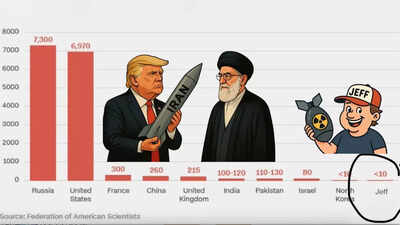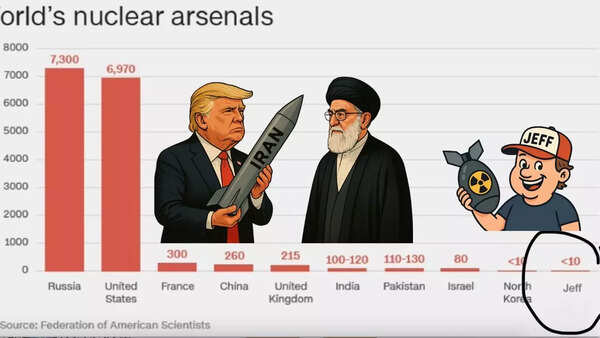
While President Donald J. Trump was issuing fresh warnings from the White House — “Iran cannot have a nuclear weapon. It’s very simple.” — a more peculiar nuclear mystery was unfolding online.
This one wasn’t about centrifuges spinning in Fordo or uranium stockpiles in Natanz. It was about Jeff.Specifically, a bar chart from CNN titled “World’s Nuclear Arsenals” listed the usual powers: Russia, the United States, France, China, the UK, and so on. But tucked away near the bottom, with fewer than 10 warheads, was an unexpected entrant: Jeff. No flag. No footnote. Just the name — as if he were a rogue microstate with a doomsday arsenal.So who is Jeff?So who is Jeff? To the casual viewer, Jeff might sound like a rogue nuclear actor. A breakaway republic? A tech billionaire with a uranium hobby? A bulky think tank guy?
The answer is disappointingly rational. JEFF stands for the Joint Evaluated Fission and Fusion File, a nuclear data library maintained by the OECD Nuclear Energy Agency (NEA). It is not a country and does not possess weapons. It compiles nuclear reaction data for civilian applications — including power generation, reactor safety, and medical isotopes.
The latest dataset, JEFF-3.3, released in 2017, is widely used across Europe.What likely happened is a labelling error: a dataset meant to be cited as the source of nuclear information was mistakenly interpreted as an entity with nuclear weapons. This misrepresentation, noted in a 2024 IFLScience article, shows how easily public understanding of complex topics can be distorted — especially when visualised without context.
Iran's Nuclear Ambitions

While social media turned Jeff into a fictional arms dealer, the real nuclear issue — Iran — continues to escalate. Trump’s administration, now back in office, has repeatedly stated that preventing Iran from acquiring a nuclear weapon is non-negotiable.Iran’s nuclear programme began under the Shah in the 1950s, with US support through President Eisenhower’s Atoms for Peace initiative. The Tehran Research Reactor was built with American assistance.
After the 1979 Islamic Revolution, the programme was briefly suspended but revived in the 1980s with help from Pakistan, Russia, and China — this time without Western oversight.By the early 2000s, Iran’s nuclear activities drew intense scrutiny. In 2002, dissident groups revealed secret enrichment facilities at Natanz and Arak, prompting IAEA investigations. Iran maintained that its goals were peaceful — energy independence and medical research — but limited inspector access and evidence of weaponisation work raised alarms.This led to the 2015 Joint Comprehensive Plan of Action (JCPOA), under which Iran agreed to restrict uranium enrichment and submit to international inspections in exchange for sanctions relief. In 2018, Trump withdrew from the deal, citing weak enforcement and sunset clauses.Since then, Iran has significantly expanded its enrichment activities. As of 2025, it is enriching uranium to 60% purity — just shy of weapons-grade — and is believed to have enough material for a bomb within weeks, if it chooses to proceed, according to IAEA assessments.Trump has responded with blunt consistency: “Iran cannot have a nuclear weapon.” Not as a slogan, but as a foreign policy red line.

 5 hours ago
31
5 hours ago
31




























 English (US)
English (US)